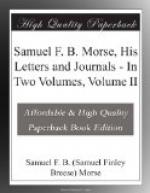“I stopped at a little distance from him to look around and down into the chasm below. It was enchanting in spite of the atmosphere of the sirocco. The hills covered with woods, at a distance, reminded me of my own country, fresh and variegated; the high peaks beyond were grey from distance, and the sides of the nearer mountains were marked with many a winding track, down one of which a shepherd and his sheep were descending, looking like a moving pathway. No noise disturbed the silence but the distant barking of the shepherd’s dog (as he, like a busy marshal, kept the order of his procession unbroken) mixing with the faint murmuring of the waterfall and the song of the birds that inhabited the ilex grove. It was altogether a place suited to meditation, and, were it consistent with those duties which man owes his fellow man, here would be the spot to which one, fond of study and averse to the noise and bustle of the world, would love to retire.”
Returning to Rome on June 3, after enjoying to the full this excursion, from which he brought back many sketches, he found the city given over to ceremony after ceremony connected with the Church. Saint’s day followed saint’s day, each with its appropriate (or, from the point of view of the New Englander, inappropriate) pageant; or some new church was dedicated and the nights made brilliant with wonderful pyrotechnical displays. He went often with pleasure to the Trinita di Monti, where the beautiful singing of the nuns gave him special pleasure.
Commenting sarcastically on a display of fireworks in honor of St. Francesco Caracciolo, he says:—
“As far as whizzing serpents, wheels, port-fires, rockets, and other varieties of pyrotechnic art could set forth the humility of the saint, it was this night brilliantly displayed.”
And again, in describing the procession of the Corpus Domini, “the most splendid of all the church ceremonies,” it is this which particularly impresses him:—
“Next came monks of the Franciscan and Capuchin orders, with their brown dresses and heads shaved and such a set of human faces I never beheld. They seemed, many of them, like disinterred corpses, for a moment reanimated to go through this ceremony, and then to sink back again into their profound sleep. Pale and haggard and unearthly, the wild eye of the visionary and the stupid stare of the idiot were seen among them, and it needed no stretch of the imagination to find in most the expression of the worst passions of our nature. They chanted as they went, their sepulchral voices echoing through the vaulted piazza, while the bell of St. Peter’s, tolling a deep bass drone, seemed a fitting accompaniment for their hymns.”
Later, on this same day, while watching a part of the ceremonies on the Gorso, he has this rather disagreeable experience:—
“I was standing close to the side of the house when, in an instant, without the slightest notice, my hat was struck off to the distance of several yards by a soldier, or rather a poltroon in a soldier’s costume, and this courteous manoeuvre was performed with his gun and bayonet, accompanied with curses and taunts and the expression of a demon in his countenance.




